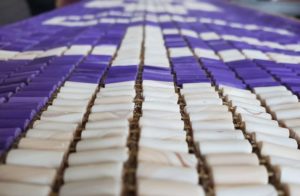Artist beads good intentions into Treaty of Niagara Belt reproduction

– Photo by Amanda Bellefeuille
By Kelly Anne Smith
NIPISSING FIRST NATION— As a youth, Amanda Bellefeuille remembers drawing in school and in her bedroom late at night when she was supposed to be sleeping.
Bellefeuille comes from a big family of artists.
“My grandfather Albert Bellaire would draw, paint and play music when he was alive. My grandmother, Eleanor McLeod Bellaire, used to do needlepoint.”
Her uncles, cousins and great-aunts are musical and there are numerous visual artists in her extended family too. Amanda expanded her artwork as an adult.
“I learned to do traditional arts – beading, sewing, leather work— when my daughter was a baby, through programming offered by Nipissing First Nation. It was at that time that my mom, Yvette Bellefeuille, decided to open a First Nation’s craft supply store.”
Recently, just before the coronavirus disease (COVID-19) pandemic, Amanda completed a commissioned work she was very proud of. She reproduced the 1764 Treaty of Niagara Belt for the Anishinabek Nation commissioned by the Restoration of Jurisdiction Department.
“It granted me an opportunity to revisit learning about this Treaty and the process and meaning behind the creation of any treaty belt. I took the time to do research and consulted with an Elder, who is an artist, on this belt so that I could recreate it to the best of my ability… Due to the age and condition of the current belt, I needed to research the pattern and oral traditions to better understand the meanings of each of the figures on the belt, the original ways of creating the beads and the history of its creation.”
“The pattern proved to be a small challenge, as there are a few variations on some of the design elements in the belt. The historical imagery kept by the government is not in detail or to scale. I needed to rely on my Elder’s knowledge and images from current reproductions in order to complete portions of the belt.”
Amanda felt honoured to be asked to recreate the Treaty of Niagara Belt. Working on it reminded her of who she is and where we come from and the pivotal time in our history with Canada. She thought about what went into the original intent of the Treaty and our current issues with the Canadian Government.
“We are living in a time where our own teachings and history appear to be growing in importance and relevance for the continuation of Treaty living. The Treaty is a living document, both in spirit and intent. Watching what was and is going on in Wet’suwet’en Territory and other territories and how Indigenous people are coming together to support our inherent rights, all while I was producing a recreation of an original Treaty belt felt surreal,” she explains. “As this was going on and I’m beading, I put intentions and hopes into each thread and each bead, as I wove this new Treaty belt together. I infused the hope that something would change, that we would realize, as a collective, that the continuation of resource extraction on our lands wasn’t viable anymore.”
Amanda explained there was an odd delay in the shipment of some of the wampum beads that had been ordered.
“They had become mixed up in the post with other packages and were sent to England. We joked about the beads visiting the Queen to remind her of the Treaty obligations in place. We eventually got them back and I was able to complete the belt. The same day that I was to drop off the belt, we were informed of COVID-19 forced closures across the country. I hoped then, and still hold to that hope, that we will take this time to reflect on our collective choices, our collective movements and make positive changes to the way that we live together going forward.”
Amanda is currently working from home as the School Wellness Lead at Nbisiing Secondary School. She is working online with students doing check-ins and providing information to help manage a variety of things that pop up.
“My artwork is an outlet for me. A time and space for me to unwind and process my emotions and thoughts, as well as process information that I’ve heard from my students. I thoroughly believe that art is an essential component of healing and I’ve tried to infuse that into my practise as much as I can. For me, right now, my artwork is helping me cope with the isolation.”
Currently, the artist’s favourite projects to spend time on are clothing and beading. She’ll be adding skirts and jackets to the inventory of the upcoming Mino Niibiish Boutique. It will be opening next to Supplies for the Soul, which is working on an online shopping experience.
“I like the flow of sewing clothing, pairing and choosing fabrics to suit a person, the quickness that a piece can be made and worn. I find the beadwork projects calming and satisfying, watching an art-piece flow and grow slowly. The small, intricate details are what I enjoy the most— the subtle shading, the texture that I can create by mixing bead sizes and types, the surprising joy and perfection that I can put into a piece when I mix colours that you wouldn’t normally place together.”


